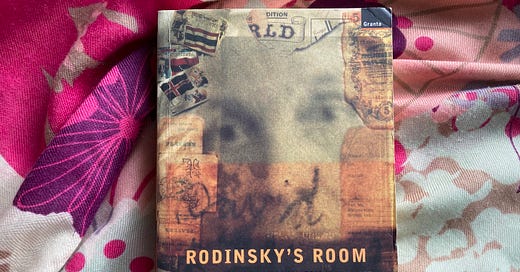Rodinsky’s Room is a book of two halves, written by Rachel Lichtenstein and Iain Sinclair.
The Authors
Rodinsky’s Room is a good introduction to these two authors, and I’ve been fortunate enough to read much of their other writing. Lichtenstein has an interest in people and life stories, and I find her easy to read. Sinclair’s staccato prose-style, in contrast, is less easy for me but his ideas are often entertainingly delivered with playful derision. They both tend to write creative non-fiction and ‘place’ is front and centre in much of their work.
The Process
The process, from what I understand, was this. Lichtenstein would write a chapter for Rodinsky’s Room then send it to Sinclair. He would then write a chapter in response. As a result I think the book feels somewhat disjointed because their styles are very different. Sinclair’s words are like an echo, they are an omnipresent force, always insightful. But, because the writing is informed and accomplished, the reading experience as a whole is quite satisfying. It’s a multi-layered narrative, enriched and enhanced by the two voices.
An extract from the book blurb:
‘Lichtenstein writes beautifully about chasing Rodinsky’s past and her own. Sinclair writes brilliantly about Lichtenstein chasing Rodinsky and herself.’ The Tablet.
What is it about?
This is the story of a man who once lived in a room above a synagogue in Whitechapel, London. He disappeared in the late 1960s and his room remained untouched for years. Lichtenstein is curious. She has permission to catalogue the contents of the room—each item could be a clue as to the man’s whereabouts: clothes, papers, books, ornaments, notes, pictures, old newspapers.
‘I unwrapped hundreds of artefacts, thousands of small scraps of paper covered in coded messages, in different languages, by his own hand.’ (Lichtenstein, p28)
‘The wardrobe was an avatar of Rodinsky, a lugubrious displacement, a vertical tomb or conjuror’s box through which he had stepped into another dimension. Rags spilled from open drawers, gravitating towards the exploded library of papers on the floor.’ (Sinclair, p69)
No-one seems to know what happened to Rodinsky and the search broadens into the local streets and areas of London that he frequented.
Is it Place Writing?
Lichtenstein embarks on a quest to trace Rodinsky and hopes to contact him if he’s still alive. This is a detective story, a mystery for sure, and gradually we learn more about the life of this man, as well as that of the author, so it becomes part biography, part memoire.
I think this book, as a collaborative work, is successful and it definitely falls into the genre of Place Writing. In fact, in my view, it’s a seminal work of Place Writing because it marks the start of what I consider to be a clearly identifiable corpus of contemporary Place Writing that begins around 1999 and continues to this day.
I’d love to know if you’ve read this book, and what you think of it.
I look forward to chatting with you in the comments!
Credits & Links:
Photo is my own.
Lichtenstein, R. & Sinclair, I. (1999) Rodinsky’s Room. London: Granta Books.
This post is part of a series of Recommended Books that in my view epitomise the genre of Place Writing.





I've never heard of this book, but what an interesting premise.